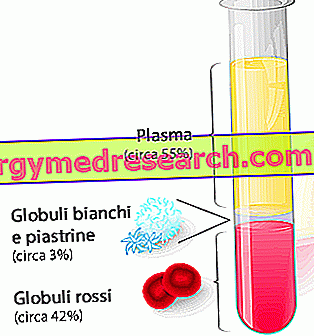Generality
The coprostasis is the stagnation of the faeces at the rectal level, followed by their hardening and drying up.
Due to constipation, coprostasis is responsible for a variety of symptoms, including: inability to defecate, abdominal discomfort, fecal incontinence, nausea, vomiting, headache, loss of appetite, loss of body weight, dehydration, fever, confusion, tachycardia, increase in respiratory rate, etc.

The coprostasis requires a causal treatment, to avoid relapses, and a symptomatic therapy, to free the intestine from dry and hard stools.
If treatment is timely, coprostasis has a benign prognosis.
Short reference to the anatomy of the intestine
The intestine is the portion of the digestive system between the pylorus and the anal orifice.
The anatomists divide it into two main sectors: the small intestine, also called small intestine, and the large intestine, also called large intestine .
The small intestine is the first section; it starts at the level of the pyloric valve, which separates it from the stomach, and ends at the level of the ileocecal valve, located on the border of the large intestine. The small intestine consists of three sections (the duodenum, the jejunum and the ileum ), is about 7 meters long and has an average diameter of 4 centimeters.
The large intestine is the terminal tract of the intestine and of the digestive system. It starts from the ileocecal valve and ends at the anus; consists of 6 sections ( cecum, ascending colon, transverse colon, descending colon, sigma and rectum ), is about 2 meters long and has an average diameter of 7 centimeters (hence the name of large intestine).
| Functions of small intestine and large intestine in brief: | |
| Small intestine | Complete digestion of foods from the stomach and provide nutrient absorption (approximately 90%). |
| Large intestine | It absorbs water and electrolytes from what comes from the small intestine and "prepares" feces for expulsion. |
What is the stool cover?
Coprostasis is the medical term that indicates the stagnation of feces in the intestinal lumen - to be precise in the lumen of the rectum - for very prolonged periods of time, which far exceed the physiological timing.
Consequences of the Stoppers
The coverslip involves an over-absorption of water from the faeces.
This absorption makes the fecal material particularly dry, compact and hard.
A greater dryness, compactness and hardness of the stools complicates - and not a little - the elimination of the latter, through the normal physiological mechanism of defecation.
Therefore, from stagnation of faeces due to the covering stasis, dry skin and hardening of the faecal material and an increased difficulty in defecation result.
Synonyms
Copostasis is also known by the not very common name of fecal impact .
Causes
The cause of coprostasis is the difficulty in evacuating the stools, in other words the so-called constipation .
The list of conditions and circumstances capable of triggering a constipation such as to induce cover-up is long, and includes:
- Excessive sedentariness. Physical inactivity impairs bowel motility;
- Dehydration. Proper hydration is essential for adequate peristalsis;
- Prolonged intake of opiate painkillers (oxycodone, codeine, methadone, hydrocodone, etc.). Among the side effects of these drugs against pain, there is also a slowing of intestinal transit, followed by the abnormal accumulation of feces at the rectal level;
- Prolonged intake of laxatives. When the use of laxatives is prolonged over time, the body tends to develop a kind of tolerance towards these drugs, which are therefore less effective;
- The insufficient supply of fibers through the diet;
- The inability to defecate when you are not away from home. This inability can cause stasis in those who, for work reasons, travel a lot and for many consecutive days;
- The act of postponing the need for defecation. It postpones the need to evacuate, for example because it is dealing with an urgent job, it can inhibit the stimuli to empty the rectum and lead, if the above behavior becomes a habit, a severe constipation;
- Diabetes mellitus;
- Hypothyroidism, a thyroid disease;
- Intestinal obstruction (or intestinal blockage);
- Persistent vomiting;
- Spinal cord injuries that impair the ability to defecate;
- Stress, anxiety and / or depression;
- Jet lag ;
- Irritable bowel syndrome (or irritable bowel syndrome or irritable bowel syndrome);
- Some autoimmune diseases, including amyloidosis, systemic lupus erythematosus, scleroderma and celiac disease;
- Some neurological diseases, such as multiple sclerosis or Parkinson's disease.
Symptoms and complications
The covering is responsible for a variety of symptoms and signs, including:
- Inability to defecate. This difficulty depends on constipation and the consequences of prolonged stagnation of the faeces in the intestine;
- Fecal incontinence (or encopresis). It consists of the involuntary loss of very often liquid stools. The episodes of fecal incontinence are very often caused by sudden coughing or loud laughter;
- Abdominal discomfort;
- Abdominal swelling;
- Abdominal pain;
- Continuous feeling of having to evacuate, without however any concrete result;
- Nausea and vomit;
- Headache and / or dizziness;
- Lack of appetite;
- Weight loss (it is clearly linked to lack of appetite).
Symptoms in severe cases
Sufferers of severe coverslip may develop, in addition to the aforementioned symptoms, even more serious disorders, such as:
- Temperature;
- Confusion;
- Tachycardia;
- Dehydration;
- Increased respiratory rate;
- agitation;
- Urinary incontinence;
- Profuse sweating.
When should I go to the doctor?
An individual with difficulty in defecating should contact the doctor or go to the nearest hospital center, when he develops the typical symptoms of the most serious cases of stasis; these circumstances, in fact, are equivalent to medical emergencies to be treated as soon as possible.
Complications
Prolonged stoppage may give rise to various complications; specifically, it can cause: hemorrhoids, anal fissure (ulceration of the anus) and blood from the anus .
Failure to treat a severe and prolonged covering should be fatal; in fact, it can cause the death of the interested party.
Diagnosis
An accurate diagnosis of stoppers - where accurate diagnosis also means identifying its causes - always involves a thorough physical examination, digital rectal exploration (generally, takes place on the occasion of the physical examination), careful anamnesis and an instrumental test to be chosen from the radiograph of the abdomen, the sigmoidoscopy and the barium enema (NB: the choice is up to the doctor and varies according to what emerged from the previous examinations).
The classic questions asked by the doctors during the anamnesis, dealing with a patient suspected of suffering from a cover-up, are:
- How long has he not defecated?
- When did you defecate the last time you had difficulty?
- Do you use laxatives?
- How much water does he drink during the day?
- What is the daily fiber intake?
- Do you take medications? If yes, which ones?
Therapy
As a rule, the treatment of coprostasis involves a causal therapy, aimed at the treatment or elimination of the triggering factor, and a symptomatic therapy, aimed in fact to empty the intestine held up by the blocked feces.
Example of causal therapy
If from the diagnostic investigations it emerges that the coprostasis is due to the prolonged assumption of an opiate painkiller, the causal therapy consists in the immediate interruption of such assumption.
Why is causal therapy important?
The causal therapy of the stoppage is important to resolve the underlying problem and to avoid relapses in the future. Without adequate causal therapy, in fact, the problem of the stoppage will tend to recur after some time.
Symptomatic therapy: the possible options
The possible treatments that allow to free the intestine from the faeces responsible for the covering are:
- Taking an oral or anal laxative . It generally represents the first solution in the face of the cases of stoppers.
The laxative failure justifies the use of more invasive treatments, such as the following ones;
- Manual removal of fecal material by digital rectal exploration . Equipped with gloves, the doctor removes the dry and hard feces with one hand, taking advantage of the anal opening;
- The execution of an enema . It foresees the insertion in the anus of the patient of a bottle filled with lubricating liquid and the subsequent squeezing of this bottle, in order to let the contents out. The lubricating liquid lubricates the rectum and moistens the feces, thus favoring the natural evacuation of the latter;
- Transanal irrigation . It foresees the insertion in the patient's rectum (clearly using the anal opening) of a small tube connected to a machine that emits warm water. The emission of water, through the system described above, allows to humidify the faeces and favor their elimination.
Prognosis
Copostasis has a benign prognosis, provided the patient does not neglect the symptoms and promptly undergo accurate diagnostic checks and all appropriate therapies.
Prevention
Among the main preventive measures, recommended by doctors, to reduce the risk of coverlets, include:
- Drink water in adequate quantities,
- do physical activity constantly,
- do not postpone the need to defecate,
- avoid prolonged and incorrect use of laxatives,
- do not recklessly take medications that promote constipation are.



